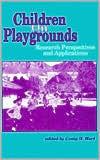
Children On Playgrounds: Research Perspectives and Applications is a collection of research and review papers edited by Craig H. Hart that sheds light on practical child development issues in the context of outdoor play environments. The book was published in 1993 by State University of New York Press.
At a time when children were given long periods of time for recess during their school day, it was thought to be an environment where children had freedom to interact in ways largely independent of adult-imposed constraints. This was seen as an opportunity for researchers to observe child behavior and development as it naturally evolves with minimal adult supervision. At the time there was little literature available that studied children’s behavior in outdoor play settings.
Chapter 1 – Introduction: Toward a Further Understanding of Children’s Development on Playgrounds was written by the editor, Craig H. Hart. In this chapter he lays out the need for research that studies children’s behaviors on the playground and gives an introduction to what will be found in the book.
Part I: History and Theory of Outdoor Play contains Chapter 2 – Historical and Contemporary Influences of Outdoor Play Environments written by Lynn Hartle and James E. Johnson. They focus on the history of playgrounds and play equipment and the different play theories that shaped the design of playgrounds, taking into account children’s physical, social, emotional, and cognitive development.
Part II: Conflicts on Playgrounds contains two chapters. Chapter 3 – Conflict and Context in Peer Relations written by William W. Hartup and Brett Laursen deals with how conflict on playgrounds without adult intervention has important implications for the development of children. Consideration of the issues regarding what conflict is and is not and how conflict is resolved in different contexts based on such things as age and gender of the children, relationships, group dynamics, and varying situations is discussed. Chapter 4 – Bullies on the Playground: The Role of Victimization contributed by Dan Olweus describes what bullying is, how frequently bullying occurs, and the family background and personality characteristics of both bullies and their victims. He suggests an intervention program and practical guidelines for helping bullies and victims.
Part III: Playground Behaviors and Peer Relations contains four chapters. Chapter 5 – Playstyles of Peer-Accepted and Peer-Rejected Children on the Playground offered by Gary W. Ladd and Joseph M. Price explores the link between children’s behaviors on the playground, their play patterns, and their acceptance or rejection by their peers.
Chapter 6 – Patterns of Social Behavior on the Playground in 9- to 11-Year-Old Girls and Boys: Relations to Teacher Perceptions and to Peer Ratings of Aggression, Withdrawal, and Likability is contributed by Lisa A. Serbin, Keith Marchessault, Valerie McAffer, Patricia Peters, and Alex E. Schwartzman. The researchers submitted results of two studies they did to examine the normal playground behaviors of fourth and fifth-grade children, specifically observing the differences in aggressive and withdrawn behaviors by boys and girls and compared their findings to teacher perceptions and peer ratings.
In Chapter 7 – Using a Wireless Transmission System to Observe Conversation and Social Interaction on the Playground, Steven R. Asher and Sonda W. Gabriel discuss the strengths and limitations of various methods of observation for recording children’s conversations in playground settings, with the particular emphasis on the advantages of wireless transmission.
Chapter 8 – Ethnic, Gender Partner, and Activity Preferences in Mixed-Race Schools in the U.K.: Playground Observations submitted by Michael J. Boulton and Peter K. Smith gives their findings in a relatively unconstrained environment like the playground, where children could be observed by race and gender to see who they chose to interact with on the playground.
Part IV: Family Background Influences and Children’s Playground Behavior contains two chapters. Chapter 9 – Children’s Aggressive and Socially Unskilled Playground Behavior with Peers: Origins in Early Family Relations written by Gregory S. Pettit and Amanda W. Harrist gives their observations of children who did not recognize relevant social-environmental cues to be socially attuned to their peers resulting in aggressive behavior, as influenced by their family interactions. Chapter 10 – Parental Disciplinary Strategies and Preschoolers’ Play Behavior in Playground Settings written by Craig H. Hart, Michele DeWolf, and Diane C. Burts focuses on comparing relationships involving maternal and paternal disciplinary strategies to resulting playground behaviors and peer status of children.
Part V: Playground Behavior and Literacy Development delves into ways that playground activities stimulate literacy development in the classroom with three chapters. In Chapter 11 – When the Playground Enters the Classroom, Becky Reimer proposes that children’s chase games on the playground transfer to reading and writing events in the classroom. Chapter 12 – The Role of Soccer in a Narrative Context by Kathryn M. Borman, Chester H. Laine, and Denis S. Lowe gives their findings that there are connections among sports, writing, gender, and school-related characteristics. Chapter 13 – Themes in the Peer Relations Literature: Correspondence to Playground Interactions Portrayed in Children’s Literature is offered by Craig H. Hart, Lea McGee, and Sue Hernandez. This chapter explores the themes of childhood relationships in peer relations studies and compares them with what has been included in children’s literature relating to acceptance and friendships of children playing on the playground.
The conclusion of this book is found in Chapter 14 – Children on Playgrounds: Applying Current Knowledge to Future Practice and Inquiry. This chapter attempts to integrate what has been shown in each of the chapters through the research presented and suggests ideas for future research and applications in playground settings.1
- 1. Hart, Craig H., editor. Children On Playgrounds: Research Perspectives and Applications. Albany, NY: State University of New York Press. 1993.

